这一节我们分析前面实现的线性表的功能和性能。
效率分析:
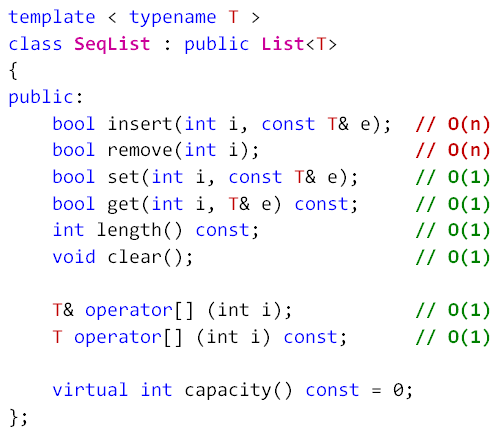
上图中给出了时间复杂度的分析,但是这还不是效率的分析。
长度相同的两个SeqList,插入和删除操作的平均耗时是否相同呢?
如下所示:
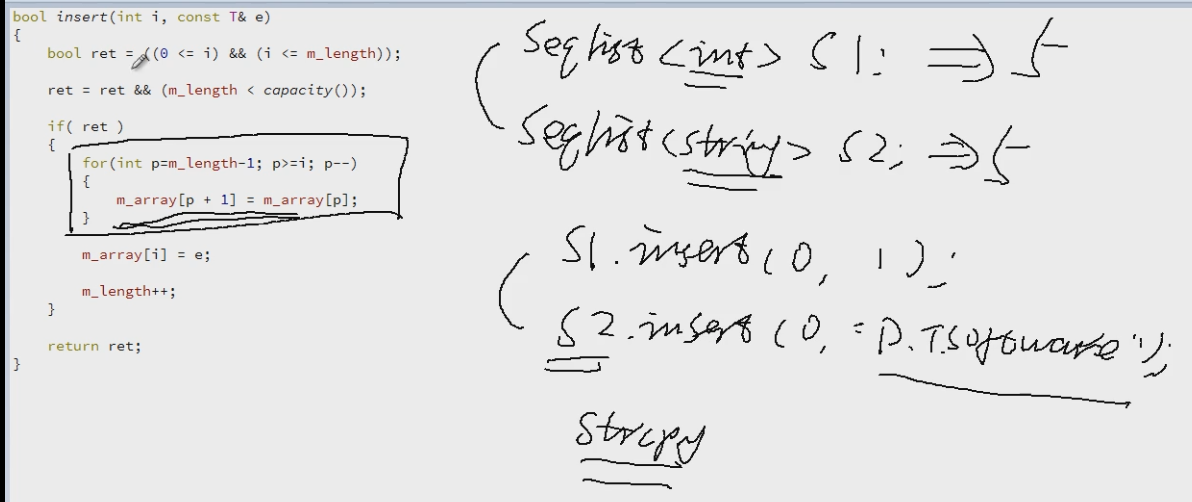
insert中最耗时的操作是那个for循环,假设两个SeqList,一个存的是int型,一个存的是string,它们的操作效率当然是不一样的,特别是当存一个很复杂的类对象时,for循环中的赋值操作会更耗时。
从上面的例子可以看出,评估一个算法的效率不能只看时间复杂度,时间复杂度只是一个参考指标,但并不是绝对的指标。我们还需要具体的分情况来考虑。
效率问题需要根据具体情况来看,基于顺序存储结构的线性表,就不适合使用类类型的对象来作为数据元素存储。
考察下面的代码:
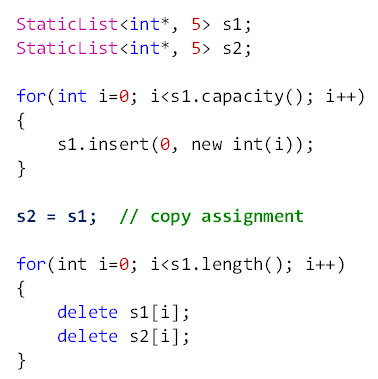
s2=s1的赋值操作会变成下面的情形:
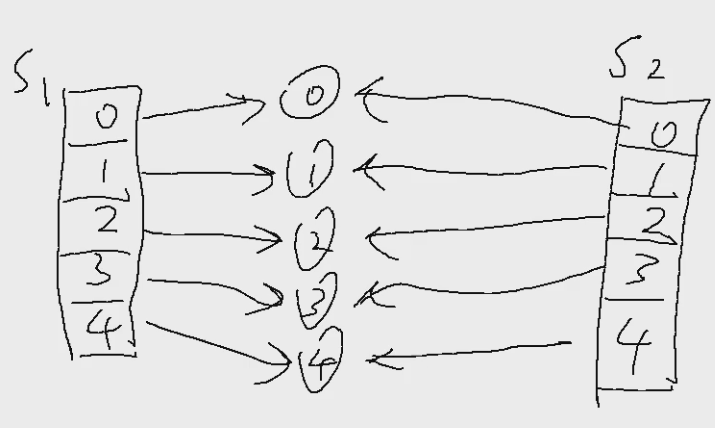
导致在释放的时候堆空间释放两次。可能会出现bug。
继续考察下面的代码:
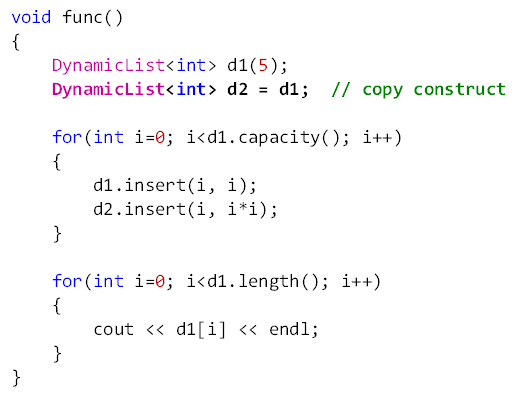
用d1拷贝构造d2,并且在for循环中给d1、d2插入元素,执行这个函数会产生如下的情形:

执行完d2=d1,它们就指向了同一片内存,后面的插入操作会覆盖前面的操作,而且在析构时会将这片空间释放两次。
如何解决上面说到的这些问题呢?
对于容器类型的类,可以考虑禁用拷贝构造和赋值操作。这是一种简单粗暴的方法。容器类完全可以使用这种方法。

改造List.h如下:
1 #ifndef LIST_H 2 #define LIST_H 3 4 #include "Object.h" 5 6 namespace DTLib 7 { 8 9 template <typename T> 10 class List : public Object 11 { 12 protected: 13 List(const List&); 14 List& operator= (const List&); 15 public: 16 List() {} 17 virtual bool insert(const T& e) = 0; 18 virtual bool insert(int i, const T& e) = 0; 19 virtual bool remove(int i) = 0; 20 virtual bool set(int i, const T& e) = 0; 21 virtual bool get(int i, T& e) const = 0; 22 virtual int length() const = 0; 23 virtual void clear() = 0; 24 }; 25 26 } 27 28 29 #endif // LIST_H
13、14行我们将拷贝构造函数和赋值操作符的重载定义为了protected的,也就相当于禁用了拷贝构造和赋值操作。定义了拷贝构造函数后,编译器就不会帮我们生成默认的构造函数了,因此,16行我们自己定义一个。
此外,我们改造SeqList.h,添加一个insert函数的重载版本:
1 #ifndef SEQLIST_H 2 #define SEQLIST_H 3 4 #include "List.h" 5 #include "Exception.h" 6 7 namespace DTLib 8 { 9 10 template <typename T> 11 class SeqList : public List<T> 12 { 13 protected: 14 T* m_array; //顺序存储空间,具体在子类中指定 15 int m_length; //当前线性表长度 16 public: 17 bool insert(int i, const T &e) 18 { 19 bool ret = ((0 <= i) && (i <= m_length)); 20 21 ret = ret && (m_length < capacity()); 22 23 if( ret ) 24 { 25 for(int p = m_length -1; p >= i; p--) 26 { 27 m_array[p + 1] = m_array[p]; 28 } 29 30 m_array[i] = e; 31 32 m_length++; 33 } 34 35 return ret; 36 } 37 38 bool insert(const T& e) 39 { 40 return insert(m_length, e); 41 } 42 43 bool remove(int i) 44 { 45 bool ret = ((0 <= i) && (i < m_length)); 46 47 if( ret ) 48 { 49 for(int p = i; p < m_length - 1; p++) 50 { 51 m_array[p] = m_array[p + 1]; 52 } 53 54 m_length--; 55 } 56 57 return ret; 58 } 59 60 bool set(int i, const T &e) 61 { 62 bool ret = ((0 <= i) && (i < m_length)); 63 64 if( ret ) 65 { 66 m_array[i] = e; 67 } 68 69 return ret; 70 } 71 72 bool get(int i, T &e) const 73 { 74 bool ret = ((0 <= i) && i < m_length); 75 76 if( ret ) 77 { 78 e = m_array[i]; 79 } 80 81 return ret; 82 } 83 84 int length() const 85 { 86 return m_length; 87 } 88 89 void clear() 90 { 91 m_length = 0; 92 } 93 //顺序存储线性表的数组访问方式 94 T& operator[](int i) 95 { 96 if((0 <= i) && (i < m_length)) 97 { 98 return m_array[i]; 99 } 100 else 101 { 102 THROW_EXCEPTION(IndexOutOfBoundsException, "Parameter i is invalid ..."); 103 } 104 } 105 106 T operator[](int i) const 107 { 108 return (const_cast<SeqList<T>&>(*this))[i]; 109 } 110 111 //顺序存储空间的容量 112 virtual int capacity() const = 0; 113 }; 114 115 } 116 117 #endif // SEQLIST_H
38-41行使我们的insert的重载版本。
main函数测试程序如下:
1 #include <iostream> 2 #include "List.h" 3 #include "SeqList.h" 4 #include "StaticList.h" 5 #include "Exception.h" 6 #include "DynamicList.h" 7 8 using namespace std; 9 using namespace DTLib; 10 11 12 int main() 13 { 14 15 DynamicList<int> l(5); 16 DynamicList<int> n = l; 17 18 return 0; 19 }
16行相当于拷贝构造,会出现编译错误,如下:

这说明我们禁用拷贝构造函数成功了。
将线性表当做数组来使用,下面的代码正确吗?

上面的程序直接执行会产生越界异常,这是为什么呢?我们的顺序表SeqList中确实重载了[]操作符,因此,可以以数组的形式访问线性表中的元素,但是前提是表中必须提前插入了元素,也就是表中相应的位置必须已经有元素了。SeqList中我们重载的[]操作符如下:
1 T& operator[](int i) 2 { 3 if((0 <= i) && (i < m_length)) 4 { 5 return m_array[i]; 6 } 7 else 8 { 9 THROW_EXCEPTION(IndexOutOfBoundsException, "Parameter i is invalid ..."); 10 } 11 }
可以看到,当表中没有元素时,m_length是0,这时我们直接以数组下标的形式访问就会产生异常。
结论就是线性表有自己的使用方式,线性表不是数组。
顺序存储结构线性表提供了数组操作符重载,通过重载能够快捷方便的获取目标位置处的数据元素,在具体的使用形式上类似数组,但由于本质不同,不能代替数组使用。线性表中重载[]只是为了在使用线性表时能快捷方便的获取元素。
要想使用[]操作符,我们需要自己实现一个数组类来代替C++中的原生数组,如下:

小结:
顺序存储线性表的插入和删除操作存在重大的效率隐患
线性表作为容器类,应该避免拷贝构造和拷贝赋值
顺序存储线性表可能被当成数组误用
工程开发中可以考虑使用数组类代替原生数组使用